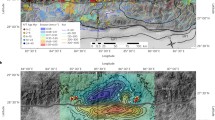Abstract
The eastern margin of the Tibetan Plateau is marked by an extremely steep mountain front with relief of over 5 km. This topography, coupled with abundant Mesozoic thrusts within the margin, explains why tectonic maps of the India-Asia collision typically show the eastern margin as a major thrust zone. Actually, it does not like that. Field observations suggest that the margin is better characterized as a zone of NNE-directed dextral shear with extensive strike-slip faulting and secondary thrusting. The high relief and steep gradients are partially explained by erosional unloading of an elastic lithosphere; the pre-erosion inherited topography may be the inherited Mesozoic thrust belt landscape modified by a component of Cenozoic tectonic shortening.
Similar content being viewed by others
References
Avouac, J. P., and Tapponnier, P. 1993. Kinematic model of active deformation in central Asia.Geophysical Research Letters 20: 895–898
Burchfiel, B. C., CHEN, Z., LIU, Y., and Royden, L.H., 1995. Tectonics of the Longmen Shan and adjacent regions.International Geology Review 37: 661–735
CHEN, S.F., Wilson, C.J.L., DENG, Q.D., ZHAO, X.L., and LUO, Z.L., 1994. Active faulting and block movement associated with large earthquakes in the Min Shan and Longmen Mountains, Northeastern Tibetan plateau.Journal of Geophysical Research 99: 24025–24038
CHEN, S. F., and Wilson, C.J.L. 1996. Emplacement of the Longmen Shan Thrust-Nappe Belt along the eastern margin of the Tibetan Plateau.Journal of Structural Geology 18: 413–430
Clark, M.K., and Royden, L.H., 2000. Topographic ooze: building the eastern margin of Tibet by lower crustal flow.Geology 28: 703–706
Dirks, P. H. G. M., Wilson, C. J. L., CHEN, S., LUO, Z. L., and LIU, S. 1994. Tectonic evolution of the NE margin of the Tibetan Plateau: evidence from the central Longmen Mountains, Sichuan Province, China.Journal of Southeast Asian Earth Sciences 9: 181–192
England, P.C., and Houseman, G.A. 1986. Finite strain calculations of continental deformation: 2, comparison with the India-Asia collision zone.Journal of Geophysical Research 91: 3664–3676
England, P., and Molnar, P. 1990. Right-lateral shear and rotation as the explanation for strike-slip faulting in eastern Tibet.Nature 344: 140–142
Gilchrist, A.R., Summerfield, M.A., and Cockburn, H.A.P. 1994. Landscape dissection, isostatic uplift, and the morphologic development of orogens.Geology 22: 963–966
Hetenyi, R. 1974.Beams on elastic foundation: Ann Arbor. University of Michigan Press. Pp 255
Holt, W.E. 2000. Correlated crust and mantle strain fields in Tibet.Geology 28: 67–70
King, G. C. P., and Ellis, M. 1990. The origin of large local uplift in extensional regions.Nature 348: 689–693
King, R. W., Shen, F., Burchfiel, B.C., Royden, L.H., Wang, E., CHEN, Z., LIU, Y., Zhang, X. Y., ZHAO, J. X., and Li, Y. 1997. Geodetic measurement of crustal motion in southwest China.Geology 25: 179–182
Kirby, E., Whipple, K. X., Burchfiel, B. C., Tang, W., Berger, G., Sun, Z., and CHEN Z. 2000. Neotectonics of the Min Shan, China: implications for mechanisms driving Quaternary deformation along the eastern margin of the Tibetan Plateau.Geological Society of America Bulletin 112: 375–393
Maggi, A., Jackson, J.A., McKenzie, D., and Priestley, K. 2000. Earthquake focal depths, effective elastic thickness, and the strength of the continental lithosphere.Geology 28: 495–498
McKenzie, D., and Farihead, D. 1997. Estimates of the effective elastic thickness of the continental lithosphere from Bouguer and free-air gravity anomalies.Journal of Geophysical Research 102: 27523–27552
Royden, L.H., Burchfiel, B.C., King, R.W., Wang, E., CHEN Z., Shen, F., and LIU, Y. 1997. Surface deformation and lower crustal flow in eastern Tibet.Science 276: 788–790
Schumm, S.A. 1987.Alluvial river response to active tectonics, in Studies in geophysics: Active tectonics. Washington D.C., National Academy Press. Pp 80–94
Stein, R. S., King, G.C.P., and Rundle, J. 1988. The growth of geologic structures by repeated earthquakes. 2, field examples of continental dip-slip faults.Journal of Geophysical Research 93: 133319–133331
WANG, E., Burchfiel, B. C., Royden, L. H., CHEN, L., CHEN, J., Li, W., and CHEN, Z. 1998. Late Cenozoic Xianshuihe-Xiaojiang, Red River, and Dali fault systems of southwestern Shichuan and central Yunnan, China.Geological Society of America Special Paper 327: 1–108
Author information
Authors and Affiliations
Rights and permissions
About this article
Cite this article
Densmore, A.L., Li, Y., Ellis, M.A. et al. Active tectonics and erosional unloading at the eastern margin of the Tibetan Plateau. J. Mt. Sci. 2, 146–154 (2005). https://doi.org/10.1007/BF02918330
Received:
Accepted:
Issue Date:
DOI: https://doi.org/10.1007/BF02918330




